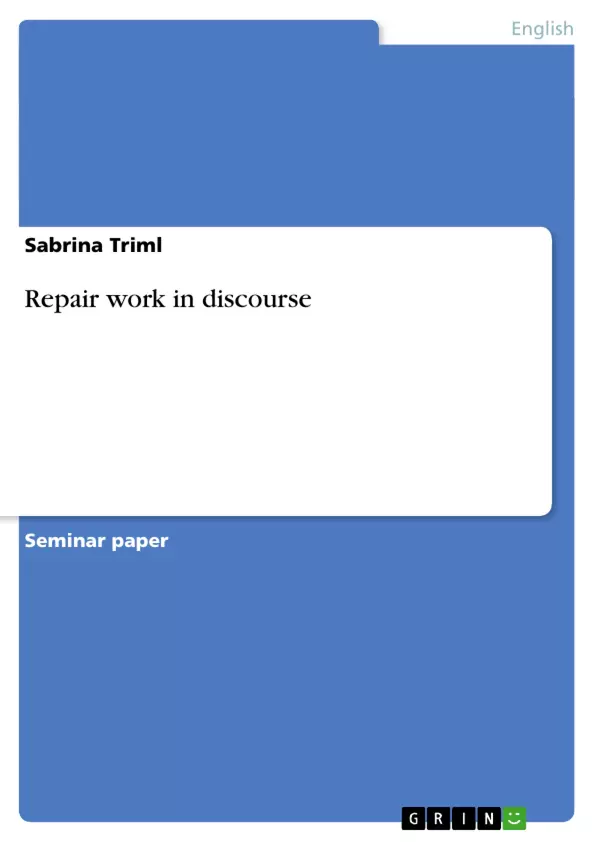Spoken discourse is a process depending on the interaction of at least two participants. They mutually construct this process and understanding is achieved by interaction. But communication is always in danger of breaking down. When people talk to each other they constantly try to avoid this breakdown by preventing misunderstandings. In writing one can carefully think about the 'right' words, reconstruct, correct and rewrite sentences or sections as often as necessary. In spoken discourse this reconstruction has to happen immediately.
Sentences or ideas are not always “brought to an end”. In order to keep discourse smooth, fluent and comprehensible participants need to repair utterances of themselves or others during speaking. It is often the case that someone notices during saying one utterance that they actually want to say something else. So they possibly stop within one sentence and bring in another idea. Thus, repair means interruption and correction of oneself or another person like: that will be forty - no fifty - dollars. In written discourse such an insertion is often indicated by means of hyphens. Likewise, clarification can happen more explicitly after questions who signal that the receiver did not understand something and/or asks for further information or a repetition of what was said before. This is often needed when discourse takes place between participants with a different status of knowledge about the topic of their conversation. All these techniques aim to produce or maintain a process of mutual understanding and keep the conversation going on.
When and how people use repair work depends on extra-linguistic factors like the topic of the conversation, the kind of discourse and where it takes place, the relationship of the participants, their age and knowledge of the used language. The aim of this paper is to point out that speakers tend to use a higher amount of repair work in informal than in formal discourse. This will be done by analysis of different dialogues within different settings. The hypothesis is that in less formal discourse in an entertaining television programme more clarifying utterances are used than in formal interviews on serious news channels. It is supposed that formal discourse types follow some underlying structures whereas informal ones are unstructured and therefore repairs are more likely to happen.
Inhaltsverzeichnis (Table of Contents)
- Introduction
- Theoretical background
- Mutually constructed discourse
- Classification of repair
- Self- and other-correction
- Self-repair
- Other-repair
- Self-initiated repair
- Other-initiated repair
- Failure
- Placement of repair
- Functions of repair
- Data analysis
- Conclusion
Zielsetzung und Themenschwerpunkte (Objectives and Key Themes)
This paper examines the phenomenon of repair work in spoken discourse, specifically focusing on the use of repair in informal versus formal settings. The aim is to demonstrate that speakers tend to utilize a higher volume of repair work in informal discourse than in formal discourse. This will be achieved through the analysis of different dialogues from various settings.
- The nature of repair work in spoken discourse
- The relationship between repair work and the formality of discourse
- The influence of extra-linguistic factors on repair work
- The role of turn-taking and conversation analysis in understanding repair
- The preference for self-correction in repair
Zusammenfassung der Kapitel (Chapter Summaries)
The introduction sets the stage by highlighting the importance of repair work in maintaining smooth and comprehensible spoken discourse. It emphasizes that repair is crucial for avoiding communication breakdowns and ensuring understanding between participants. The introduction also introduces the research question and hypothesis: that informal discourse exhibits a higher frequency of repair work compared to formal discourse.
The theoretical background chapter delves into the concept of mutually constructed discourse, emphasizing that conversation is a dynamic process that relies on interaction and negotiation between participants. It introduces key theories of repair work, rooted in ethnomethodology and conversation analysis, which view discourse as a developing process rather than a finished product.
The chapter on classification of repair provides a detailed taxonomy of repair types, including self-repair, other-repair, self-initiated repair, other-initiated repair, and failure. It explores the distinction between self- and other-correction, highlighting the preference for self-correction in repair.
The chapter on data analysis, while not summarized here, will likely delve into the analysis of specific dialogues to demonstrate the proposed relationship between repair work and the formality of discourse.
Schlüsselwörter (Keywords)
The primary focus of this paper is repair work in discourse, including self-repair, other-repair, self-initiated repair, other-initiated repair, and failure. It examines the influence of formality, turn-taking, conversation analysis, ethnomethodology, and extra-linguistic factors on repair work. The paper aims to contribute to the understanding of how speakers use repair to ensure comprehension and maintain smooth communication flow.
- Arbeit zitieren
- Sabrina Triml (Autor:in), 2000, Repair work in discourse, München, GRIN Verlag, https://www.grin.com/document/83492



